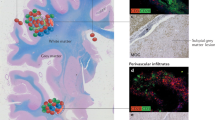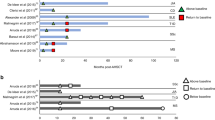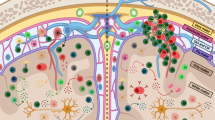Abstract
New so-called immune reconstitution therapies (IRTs) have the potential to induce long-term or even permanent drug-free remission in people with multiple sclerosis (MS). These therapies deplete components of the immune system with the aim of allowing the immune system to renew itself. Haematopoietic stem cell transplantation, the oral formulation cladribine and the monoclonal antibodies alemtuzumab, rituximab and ocrelizumab are frequently categorized as IRTs. However, the evidence that IRTs indeed renew adaptive immune cell repertoires and rebuild a healthy immune system in people with MS is variable. Instead, IRTs might foster the expansion of those cells that survive immunosuppression, and this expansion could be associated with acquisition of new functional phenotypes. Understanding immunological changes induced by IRTs and how they correlate with clinical outcomes will be instrumental in guiding the optimal use of immune reconstitution as a durable therapeutic strategy. This Perspectives article critically discusses the efficacy and potential mechanisms of IRTs in the context of immune system renewal and durable disease remission in MS.
This is a preview of subscription content, access via your institution
Access options
Access Nature and 54 other Nature Portfolio journals
Get Nature+, our best-value online-access subscription
$29.99 / 30 days
cancel any time
Subscribe to this journal
Receive 12 print issues and online access
$209.00 per year
only $17.42 per issue
Buy this article
- Purchase on Springer Link
- Instant access to full article PDF
Prices may be subject to local taxes which are calculated during checkout
Similar content being viewed by others
Change history
14 January 2020
A Correction to this paper has been published: https://doi.org/10.1038/s41582-020-0310-1
References
Lucchinetti, C. et al. Heterogeneity of multiple sclerosis lesions: implications for the pathogenesis of demyelination. Ann. Neurol. 47, 707–717 (2000).
Babbe, H. et al. Clonal expansions of CD8+ T cells dominate the T cell infiltrate in active multiple sclerosis lesions as shown by micromanipulation and single cell polymerase chain reaction. J. Exp. Med. 192, 393–404 (2000).
Palanichamy, A. et al. Immunoglobulin class-switched B cells form an active immune axis between CNS and periphery in multiple sclerosis. Sci. Transl Med. 6, 248ra106 (2014).
Obermeier, B. et al. Matching of oligoclonal immunoglobulin transcriptomes and proteomes of cerebrospinal fluid in multiple sclerosis. Nat. Med. 14, 688–693 (2008).
Qin, Y. et al. Clonal expansion and somatic hypermutation of V(H) genes of B cells from cerebrospinal fluid in multiple sclerosis. J. Clin. Invest. 102, 1045–1050 (1998).
Baecher-Allan, C., Kaskow, B. J. & Weiner, H. L. Multiple sclerosis: mechanisms and immunotherapy. Neuron 97, 742–768 (2018).
Wekerle, H., Flugel, A., Fugger, L., Schett, G. & Serreze, D. Autoimmunity’s next top models. Nat. Med. 18, 66–70 (2012).
International Multiple Sclerosis Genetics Consortium. et al. Analysis of immune-related loci identifies 48 new susceptibility variants for multiple sclerosis. Nat. Genet. 45, 1353–1360 (2013).
Billingham, R. E., Brent, L. & Medawar, P. B. Actively acquired tolerance of foreign cells. Nature 172, 603–606 (1953).
Qin, S. et al. “Infectious” transplantation tolerance. Science 259, 974–977 (1993).
Piotti, G., Ma, J., Adams, E., Cobbold, S. & Waldmann, H. Guiding postablative lymphocyte reconstitution as a route toward transplantation tolerance. Am. J. Transpl. 14, 1678–1689 (2014).
Sun, B. et al. Non-depleting anti-CD4 monoclonal antibody induces immune tolerance to ERT in a murine model of Pompe disease. Mol. Genet. Metab. Rep. 1, 446–450 (2014).
Kawai, T. et al. Long-term results in recipients of combined HLA-mismatched kidney and bone marrow transplantation without maintenance immunosuppression. Am. J. Transpl. 14, 1599–1611 (2014).
Thompson, A. J., Baranzini, S. E., Geurts, J., Hemmer, B. & Ciccarelli, O. Multiple sclerosis. Lancet 391, 1622–1636 (2018).
Mexhitaj, I. et al. Abnormal effector and regulatory T cell subsets in paediatric-onset multiple sclerosis. Brain 142, 617–632 (2019).
Hohlfeld, R., Dornmair, K., Meinl, E. & Wekerle, H. The search for the target antigens of multiple sclerosis, part 1: autoreactive CD4+ T lymphocytes as pathogenic effectors and therapeutic targets. Lancet Neurol. 15, 198–209 (2016).
Atkins, H. L. et al. Immunoablation and autologous haemopoietic stem-cell transplantation for aggressive multiple sclerosis: a multicentre single-group phase 2 trial. Lancet 388, 576–585 (2016).
Muraro, P. A. et al. Autologous haematopoietic stem cell transplantation for treatment of multiple sclerosis. Nat. Rev. Neurol. 13, 391–405 (2017).
Tuohy, O. et al. Alemtuzumab treatment of multiple sclerosis: long-term safety and efficacy. J. Neurol. Neurosurg. Psychiatry 86, 208–215 (2015).
Hauser, S. L. et al. B-cell depletion with rituximab in relapsing-remitting multiple sclerosis. N. Engl. J. Med. 358, 676–688 (2008).
von Essen, M. R. et al. Proinflammatory CD20+ T cells in the pathogenesis of multiple sclerosis. Brain 142, 120–132 (2019).
Cross, A. H., Stark, J. L., Lauber, J., Ramsbottom, M. J. & Lyons, J. A. Rituximab reduces B cells and T cells in cerebrospinal fluid of multiple sclerosis patients. J. Neuroimmunol. 180, 63–70 (2006).
Martin Mdel, P. et al. Depletion of B lymphocytes from cerebral perivascular spaces by rituximab. Arch. Neurol. 66, 1016–1020 (2009).
Duddy, M. et al. Distinct effector cytokine profiles of memory and naive human B cell subsets and implication in multiple sclerosis. J. Immunol. 178, 6092–6099 (2007).
Bar-Or, A. et al. Abnormal B-cell cytokine responses a trigger of T-cell-mediated disease in MS? Ann. Neurol. 67, 452–461 (2010).
Barr, T. A. et al. B cell depletion therapy ameliorates autoimmune disease through ablation of IL-6-producing B cells. J. Exp. Med. 209, 1001–1010 (2012).
Li, R. et al. Proinflammatory GM-CSF-producing B cells in multiple sclerosis and B cell depletion therapy. Sci. Transl Med. 7, 310ra166 (2015).
Stasi, R. et al. Analysis of regulatory T-cell changes in patients with idiopathic thrombocytopenic purpura receiving B cell-depleting therapy with rituximab. Blood 112, 1147–1150 (2008).
Maurer, M. A. et al. Rituximab induces sustained reduction of pathogenic B cells in patients with peripheral nervous system autoimmunity. J. Clin. Invest. 122, 1393–1402 (2012).
Hausler, D. et al. Functional characterization of reappearing B cells after anti-CD20 treatment of CNS autoimmune disease. Proc. Natl Acad. Sci. USA. 115, 9773–9778 (2018).
Pellkofer, H. L. et al. Long-term follow-up of patients with neuromyelitis optica after repeated therapy with rituximab. Neurology 76, 1310–1315 (2011).
Kim, S. H., Huh, S. Y., Lee, S. J., Joung, A. & Kim, H. J. A 5-year follow-up of rituximab treatment in patients with neuromyelitis optica spectrum disorder. JAMA Neurol. 70, 1110–1117 (2013).
Stuve, O. et al. Long-term B-lymphocyte depletion with rituximab in patients with relapsing-remitting multiple sclerosis. Arch. Neurol. 66, 259–261 (2009).
Havrdova, E. et al. Alemtuzumab CARE-MS I 5-year follow-up: durable efficacy in the absence of continuous MS therapy. Neurology 89, 1107–1116 (2017).
Rodig, S. J. et al. Heterogeneous CD52 expression among hematologic neoplasms: implications for the use of alemtuzumab (CAMPATH-1H). Clin. Cancer Res. 12, 7174–7179 (2006).
Thompson, S. A., Jones, J. L., Cox, A. L., Compston, D. A. & Coles, A. J. B-cell reconstitution and BAFF after alemtuzumab (Campath-1H) treatment of multiple sclerosis. J. Clin. Immunol. 30, 99–105 (2010).
Jones, J. L. et al. IL-21 drives secondary autoimmunity in patients with multiple sclerosis, following therapeutic lymphocyte depletion with alemtuzumab (Campath-1H). J. Clin. Invest. 119, 2052–2061 (2009).
De Mercanti, S. et al. Alemtuzumab long-term immunologic effect: Treg suppressor function increases up to 24 months. Neurol. Neuroimmunol. Neuroinflamm. 3, e194 (2016).
Jones, J. L. et al. Human autoimmunity after lymphocyte depletion is caused by homeostatic T-cell proliferation. Proc. Natl Acad. Sci. USA 110, 20200–20205 (2013).
Kim, Y. et al. Restoration of regulatory B cell deficiency following alemtuzumab therapy in patients with relapsing multiple sclerosis. J. Neuroinflamm. 15, 300 (2018).
Zhang, X. et al. Differential reconstitution of T cell subsets following immunodepleting treatment with alemtuzumab (anti-CD52 monoclonal antibody) in patients with relapsing-remitting multiple sclerosis. J. Immunol. 191, 5867–5874 (2013).
Cooles, F. A. et al. Immune reconstitution 20 years after treatment with alemtuzumab in a rheumatoid arthritis cohort: implications for lymphocyte depleting therapies. Arthritis Res. Ther. 18, 302 (2016).
Gelfand, J. M., Cotter, J., Klingman, J., Huang, E. J. & Cree, B. A. Massive CNS monocytic infiltration at autopsy in an alemtuzumab-treated patient with NMO. Neurol. Neuroimmunol. Neuroinflamm. 1, e34 (2014).
Azzopardi, L., Cox, A. L., McCarthy, C. L., Jones, J. L. & Coles, A. J. Alemtuzumab use in neuromyelitis optica spectrum disorders: a brief case series. J. Neurol. 263, 25–29 (2016).
Ruck, T. et al. ALAIN01–alemtuzumab in autoimmune inflammatory neurodegeneration: mechanisms of action and neuroprotective potential. BMC Neurol. 16, 34 (2016).
Pfeuffer, S. et al. Alemtuzumab-induced changes in cerebrospinal fluid immune cell pattern — a prospective observational study [abstract P1200]. Mult. Scler. 24, 677–678 (2018).
Giovannoni, G. et al. A placebo-controlled trial of oral cladribine for relapsing multiple sclerosis. N. Engl. J. Med. 362, 416–426 (2010).
Giovannoni, G. et al. Safety and efficacy of cladribine tablets in patients with relapsing-remitting multiple sclerosis: results from the randomized extension trial of the CLARITY study. Mult. Scler. 24, 1594–1604 (2018).
Robertson, L. E. et al. Induction of apoptotic cell death in chronic lymphocytic leukemia by 2-chloro-2’-deoxyadenosine and 9-beta-d-arabinosyl-2-fluoroadenine. Blood 81, 143–150 (1993).
Wiendl, H. Cladribine — an old newcomer for pulsed immune reconstitution in MS. Nat. Rev. Neurol. 13, 573–574 (2017).
Baker, D. et al. Both cladribine and alemtuzumab may effect MS via B-cell depletion. Neurol. Neuroimmunol. Neuroinflamm. 4, e360 (2017).
Ceronie, B. et al. Cladribine treatment of multiple sclerosis is associated with depletion of memory B cells. J. Neurol. 265, 1199–1209 (2018).
Rejdak, K., Stelmasiak, Z. & Grieb, P. Cladribine induces long lasting oligoclonal bands disappearance in relapsing multiple sclerosis patients: 10-year observational study. Multiple Scler. Relat. Disord. 27, 117–120 (2019).
Laugel, B. et al. Cladribine inhibits cytokine secretion by T cells independently of deoxycytidine kinase activity. J. Neuroimmunol. 240–241, 52–57 (2011).
Korsen, M., Bragado Alonso, S., Peix, L., Broker, B. M. & Dressel, A. Cladribine exposure results in a sustained modulation of the cytokine response in human peripheral blood mononuclear cells. PloS one 10, e0129182 (2015).
Mitosek-Szewczyk, K. et al. Impact of cladribine therapy on changes in circulating dendritic cell subsets, T cells and B cells in patients with multiple sclerosis. J. Neurol. Sci. 332, 35–40 (2013).
Kraus, S. H. et al. Cladribine exerts an immunomodulatory effect on human and murine dendritic cells. Int. Immunopharmacol. 18, 347–357 (2014).
Kopadze, T., Dobert, M., Leussink, V. I., Dehmel, T. & Kieseier, B. C. Cladribine impedes in vitro migration of mononuclear cells: a possible implication for treating multiple sclerosis. Eur. J. Neurol. 16, 409–412 (2009).
Musella, A. et al. Cladribine interferes with IL-1beta synaptic effects in experimental multiple sclerosis. J. Neuroimmunol. 264, 8–13 (2013).
Fassas, A. et al. Peripheral blood stem cell transplantation in the treatment of progressive multiple sclerosis: first results of a pilot study. Bone Marrow Transplant. 20, 631–638 (1997).
Snowden, J. A. et al. Evolution, trends, outcomes, and economics of hematopoietic stem cell transplantation in severe autoimmune diseases. Blood Adv. 1, 2742–2755 (2017).
Muraro, P. A. et al. Long-term outcomes after autologous hematopoietic stem cell transplantation for multiple sclerosis. JAMA Neurol. 74, 459–469 (2017).
Burt, R. K. et al. Effect of nonmyeloablative hematopoietic stem cell transplantation vs continued disease-modifying therapy on disease progression in patients with relapsing-remitting multiple sclerosis: a randomized clinical trial. JAMA 321, 165–174 (2019).
Fassas, A. et al. Autologous stem cell transplantation in progressive multiple sclerosis — an interim analysis of efficacy. J. Clin. Immunol. 20, 24–30 (2000).
Moore, J. et al. A pilot randomized trial comparing CD34-selected versus unmanipulated hemopoietic stem cell transplantation for severe, refractory rheumatoid arthritis. Arthritis Rheum. 46, 2301–2309 (2002).
Feng, X. et al. Rabbit ATG but not horse ATG promotes expansion of functional CD4+CD25highFOXP3+ regulatory T cells in vitro. Blood 111, 3675–3683 (2008).
Kekre, N. & Antin, J. H. ATG in allogeneic stem cell transplantation: standard of care in 2017? Counterpoint. Blood Adv. 1, 573–576 (2017).
Palchaudhuri, R. et al. Non-genotoxic conditioning for hematopoietic stem cell transplantation using a hematopoietic-cell-specific internalizing immunotoxin. Nat. Biotechnol. 34, 738–745 (2016).
de Andrade Pereira, B. et al. Tolerance of activated pathogenic CD4+ T cells by transcriptional targeting of dendritic cells. Gene Ther. 22, 382–390 (2015).
Muraro, P. A. et al. Thymic output generates a new and diverse TCR repertoire after autologous stem cell transplantation in multiple sclerosis patients. J. Exp. Med. 201, 805–816 (2005).
Alexander, T. et al. Depletion of autoreactive immunologic memory followed by autologous hematopoietic stem cell transplantation in patients with refractory SLE induces long-term remission through de novo generation of a juvenile and tolerant immune system. Blood 113, 214–223 (2009).
Muraro, P. A. et al. T cell repertoire following autologous stem cell transplantation for multiple sclerosis. J. Clin. Invest. 124, 1168–1172 (2014).
Mondria, T., Lamers, C. H., te Boekhorst, P. A., Gratama, J. W. & Hintzen, R. Q. Bone-marrow transplantation fails to halt intrathecal lymphocyte activation in multiple sclerosis. J. Neurol. Neurosurg. Psychiatry 79, 1013–1015 (2008).
Saiz, A. et al. MRI and CSF oligoclonal bands after autologous hematopoietic stem cell transplantation in MS. Neurology 56, 1084–1089 (2001).
Nash, R. A. et al. High-dose immunosuppressive therapy and autologous HCT for relapsing-remitting MS. Neurology 88, 842–852 (2017).
Korn, T. & Kallies, A. T cell responses in the central nervous system. Nat. Rev. Immunol. 17, 179–194 (2017).
Darlington, P. J. et al. Diminished Th17 (not Th1) responses underlie multiple sclerosis disease abrogation after hematopoietic stem cell transplantation. Ann. Neurol. 73, 341–354 (2013).
Abrahamsson, S. V. et al. Non-myeloablative autologous haematopoietic stem cell transplantation expands regulatory cells and depletes IL-17 producing mucosal-associated invariant T cells in multiple sclerosis. Brain 136, 2888–2903 (2013).
de Paula, A. S. A. et al. Autologous haematopoietic stem cell transplantation reduces abnormalities in the expression of immune genes in multiple sclerosis. Clin. Sci. 128, 111–120 (2015).
Arruda, L. C. et al. Autologous hematopoietic SCT normalizes miR-16, -155 and -142-3p expression in multiple sclerosis patients. Bone Marrow Transplant. 50, 380–389 (2015).
Alexander, T. et al. SCT for severe autoimmune diseases: consensus guidelines of the European Society for Blood and Marrow Transplantation for immune monitoring and biobanking. Bone Marrow Transplant. 50, 173–180 (2015).
Schulze-Koops, H. Lymphopenia and autoimmune diseases. Arthritis Res. Ther. 6, 178–180 (2004).
Daniels, G. H. et al. Alemtuzumab-related thyroid dysfunction in a phase 2 trial of patients with relapsing-remitting multiple sclerosis. J. Clin. Endocrinol. Metab. 99, 80–89 (2014).
Willis, M. D. et al. Sarcoidosis following alemtuzumab treatment for multiple sclerosis. Multiple Scler. J. 24, 1779–1782 (2018).
Wiendl, H., Calabresi, P. A. & Meuth, S. G. Defining response profiles after alemtuzumab: rare paradoxical disease exacerbation. Neurology 90, 309–311 (2018).
Sakaguchi, N., Miyai, K. & Sakaguchi, S. Ionizing radiation and autoimmunity. Induction of autoimmune disease in mice by high dose fractionated total lymphoid irradiation and its prevention by inoculating normal T cells. J. Immunol. 152, 2586–2595 (1994).
Acknowledgements
The authors acknowledge support by the Swiss National Science Foundation (grant 31003A_169664 to J.D.L.), the German Ministry of Education, Science, Research and Technology (BMBF, German Competence Network of MS (KKNMS)) (grant 01GI1603D to T.R. and grant FKZ01FI1603A to H.W.), the Collaborative Research Centre TR-128 ‘Initiating/Effector versus Regulatory Mechanisms in Multiple Sclerosis – Progress towards Tackling the Disease’ (project A09, A10 and Z02 to H.W.), the National Institute of Health Research (project 16/126/26 to P.A.M.), the National Institute of Health Research Biomedical Research Centre funding scheme to Imperial College London (P.A.M.) and the NIH Penn Autoimmunity Centers of Excellence (A.B.O.).
Author information
Authors and Affiliations
Contributions
All authors contributed to researching data for the article, discussions of its content, writing and review and/or editing of the manuscript before submission.
Corresponding author
Ethics declarations
Competing interests
The authors declare no competing interests.
Additional information
Peer review information
Nature Reviews Neurology thanks A. Coles and J. Snowden for their contribution to the peer review of this work.
Publisher’s note
Springer Nature remains neutral with regard to jurisdictional claims in published maps and institutional affiliations.
Rights and permissions
About this article
Cite this article
Lünemann, J.D., Ruck, T., Muraro, P.A. et al. Immune reconstitution therapies: concepts for durable remission in multiple sclerosis. Nat Rev Neurol 16, 56–62 (2020). https://doi.org/10.1038/s41582-019-0268-z
Accepted:
Published:
Issue Date:
DOI: https://doi.org/10.1038/s41582-019-0268-z
This article is cited by
-
Border-associated macrophages in the central nervous system
Journal of Neuroinflammation (2024)
-
Transcriptome alterations in peripheral blood B cells of patients with multiple sclerosis receiving immune reconstitution therapy
Journal of Neuroinflammation (2023)
-
Bruton tyrosine kinase inhibitors for multiple sclerosis
Nature Reviews Neurology (2023)
-
Mass cytometry reveals cladribine-induced resets among innate lymphoid cells in multiple sclerosis
Scientific Reports (2022)
-
Neurological update: treatment escalation in multiple sclerosis patients refractory to fingolimod—potentials and risks of subsequent highly active agents
Journal of Neurology (2022)



